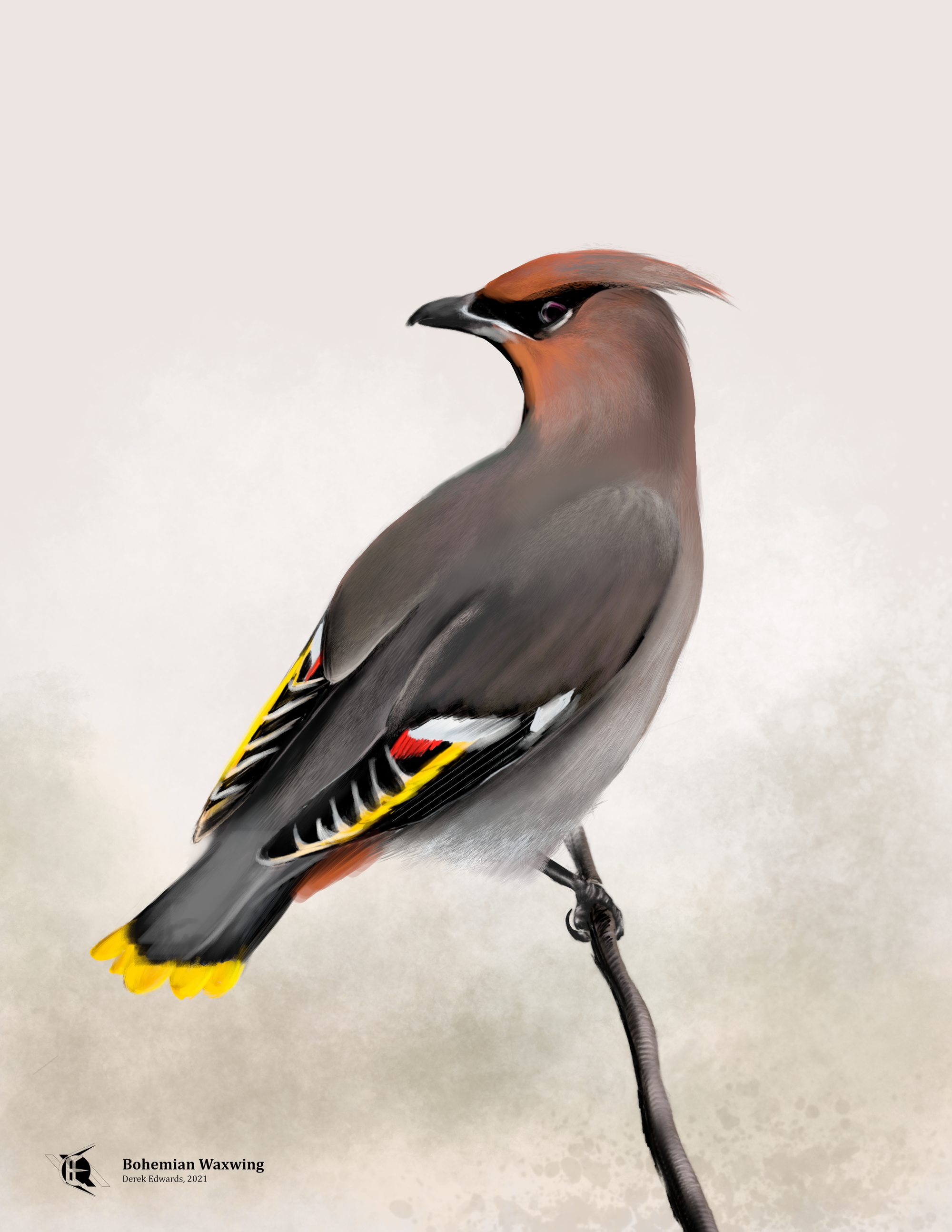
Running Commentary 8/21/2023
Hello,
I'm afraid I didn't have much time to write up this week's newsletter. Thankfully I don't have much to write about, anyway. I got commissioned to draw a bird, and I don't have that quite wrapped up yet, so I went back and touched up my drawing of a Bohemian waxwing, which I've never been very happy with, to re-feature this week.
Anyway...
Watching...

Star Wars: Visions
The ninth and final short of Visions' second volume, "Aau's Song", comes from the South African animation studio Triggerfish. Here are my thoughts on it and on this volume overall:
- I've really gotta say Visions Vol. 2 saved the best for last. "Aau's Song" is just about perfect. The music was great, the animation was both absolutely gorgeous and quite unique, and the story told was one of the better in this volume. It's very Star Wars without being the sort of stock Star Wars plot we got in some other Visions shorts.
- This short is very much aimed at kids, but it's done well enough I think anyone could appreciate it.
- No one's getting added to The List from this, but the voice performances were all pretty good.
- I thought Volume 2 of Visions was a step forward in terms of expanding the project around the world and getting different takes on Star Wars from all over, but a step backward in terms of telling distinct stories. More than half of these shorts were about young girls discovering they have Force powers, and almost half just featured the Empire as the villain. Compare that to Volume 1, which rarely featured anything straight out of the movies, and which featured all sorts of main characters. But I also didn't flat dislike any of Volume 2's shorts, while there were one or two from Volume 1 I'd recommend skipping. Volume 2's all at least worth a shot to watch. I'd say "Aau's Song", "The Spy Dancer", and "Screecher's Reach" were the standouts, with "Sith" getting a special mention for sheer visual style.
Alright, next week we'll have the premiere of Ahsoka, a full day earlier than promised. Since it'll be releasing new episodes on Tuesday, my review notes will be coming nearly a week later than the episodes, which isn't great, but we'll make it work.

Bird of the Week
This week we have a waxwing. What's a waxwing? It's any of three sleek-looking passerine birds classified together in the genus Bombycilla, which are named for the bare, red tips of the shafts some of their wing feathers that extend out of their plumage, looking something like drips of sealing wax. North America is home to the brown-and-yellow cedar waxwing. East Asia is home to the rosy-colored Japanese waxwing, unique for having a red rather than yellow tail-tip. And the northern quarter of the world is home to this week's bird, the large, gray Bohemian Waxwing.
Waxwings can often be seen catching small insects on the wing, especially near water. Their preferred food, however, is berries. They will eat hundreds of berries in a sitting if left undisturbed. This diet, being high in sugar, makes them relatively thirsty birds, especially in the winter, when berries are less juicy; waxwings have been observed eating snow for water. In early Spring, they will also feed on the dripping sap of maple and birch trees. Because overripe berries are prone to fermentation, waxwings have especially large livers and are more capable than most creatures of metabolizing ethanol. Despite this, late-season berry binges can result in the birds becoming drunk, to the point of colliding fatally with obstacles afterward.
The Bohemian waxwing can be found in Alaska and Canada during the summer, and in some northern states of the U.S. during the winter. They are also found breeding in Scandinavia and northern Russia, traveling in Winter down as far south as Japan, China, the Caucasus, and central Europe, including, yes, Bohemia, a region that was formerly part of the Habsburg Empire and which now comprises, along with Moravia, the Czech Republic.
Conrad Gessner first called the birds "Bohemian" when he wrote of Garrulus Bohemicus. The word garrulus, which today is the species name, means "talkative" in Latin, and was initially applied to the Eurasian Jay, which Gessner thought the waxwings resembled (though they, themselves, are not especially vocal birds). Gessner called them Bohemicus perhaps in reference to the actual region of Bohemia, or perhaps because they wandered about in a manner reminiscent of Bohemia's Romani population. The modern genus name Bombycilla is Latin for "silk-tail", which is the translation of the Bohemian waxwing's colloquial German name, seidenschwänze, made by the French ornithologist Louis Jean Pierre Vieillot as part of his project to adopt Linnaean Latin binomials for all birds. Germans also sometimes call these birds unglückvogel, that is, "disaster bird". This, and the Dutch name pestvogel, refer to the fact that these birds arrive in those regions at the beginning of what we might now call cold and flu season, when disease, and associated mortality, peaks for the year.
Curation Links
Stacked | Harvard Law Review
A look at charge stacking, the ignoble if perhaps inevitable practice of prosecutors breaking the actions undertaken during a crime into as many separate charges as possible, in order to maximize the potential jail time an accused person faces should their case go to trial. This practice encourages the accused to accept a plea deal rather than maintain their innocence.
The Booj Strikes Back | Twenty Thousand Hertz
[AUDIO] “In the 80s and 90s, movie trailers were ruled by ‘voice-of-God’ narrators who used stock phrases like, ‘In a world…’ Today, movie studios have a different trick up their sleeves: epic sound design. In this episode, Professor James Deaville explains the history of trailers, and Youtuber Craven Moorhaus crafts a hilarious takedown of the overused clichés of modern blockbuster trailers.” (28 minutes)
How the Wiffle Ball Came To Be | David Kindy, Smithsonian Magazine
A history of those little plastic baseball things, first designed to make it easier for children to throw curve balls, and now the centerpiece of their own spin-off sport.
The Puppetmaster | Kemi Ashing-Giwa, Tor
[FICTION] A banished warrior teaches her treacherous uncle that once made, some oaths cannot be broken…and some monsters cannot be chained.
See the full archive of curations on Notion






Member Commentary